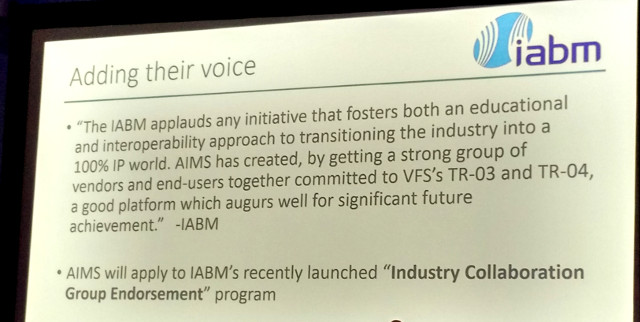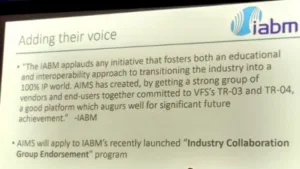The Alliance for IP Media Solutions (AIMS) had its coming out party at NAB 2016. Thence is composed of key industry organizations such as SMPTE, EBU, VSF and AMWA, plus many companies. The mission is to help coordinate open standards development for delivery and distribution of video, audio, and metadata over IP. It will also help promote industry interoperability solutions for media over IP.
The not-for-profit organization organized just 4 months ago, endorses an IP transition plan that includes support for VSF TR-03 and TR-04, SMPTE 2022-6 and AES67. So far there are 30 members.
At NAB, a press conference and panel discussion was held with the participating organizations while on the show floor there were numerous demos in company booths that showcased the interoperability of equipment for video over IP. This included demos at Arista Networks, EVS, Grass Valley, Harmonic, Imagine Communications and Nevion. At NAB, AIMS also announced new members: Sony, Fox Networks Group, Avid, Dejero, Ikegami, IntoPIX, Matrox, NEC, TVU Networks and Evertz.
The panel discussion included the following organizations and speakers
- LiveIP – Michel DeWolf, founder of Belgium-based creative engineering company DWESAM
- Society of Motion Picture and Television Engineers (SMPTE) – Howard Lukk, Director of Standards
- European Broadcast Union (EBU) – Hans Hoffmann, Senior Manager
- Video Services Forum (VSF) – Richard Friedel, President
- Advanced Media Workflow Association (AMWA) – Brad Gilmer, Executive Director
SMPTE is the standard development organization in the group and is a deliberative body that usually moves fairly slowly. “We are trying to move faster, however, because IT is driving change,” commented Lukk.
Hoffman explained that the EBU’s job is to develop requirements for the industry to help guide in standards development with organizations like SMPTE and ISO.
VSF and AMWA are trade organization that provides the input from industry and also helps to implement new standards once approved. VSF is video focused while AMWA is more software focused. Gilmer and Friedel noted that they can move faster than standards bodies, and given the rapid pace of advancements in the IT community, they have an important role to play.
Friedel said that the 2022 standards started in work groups in VSF and were transitioned to SMPTE to turn into standards. Lukk said that SMPTE does not invent technologies and solutions, it gets them from industry and then does a deep review to help ensure they are robust and ready for standardization.
LiveIP is a full production company that began producing content and distributing over IP about a year ago. It is working with a Belgian broadcaster doing broadcasts over IP and working on the next level of interoperability with other equipment.
The panel was asked if those who start using media over IP are saving money, but the response was that this was not the right question. The reality is that users can do things they could not do in the pure SDI world and once migrated, they do not want to go back.
They suggested that a better question is how can media over IP help monetize the distribution of content onto any platform? The panel members said this is really an opportunity to rethink traditional workflows to gain real advantages and benefits.

The meeting closed with an acknowledgement of support and cooperation from the International Association of Broadcast Manufacturers (IABM), a trade association of 450 broadcast companies.
To learn more, visit the alliance website at www.aimsalliance.org and download the Alliance for IP Media Solutions’ white paper “An Argument for Open IP Standards in the Media Industry.” – CC

